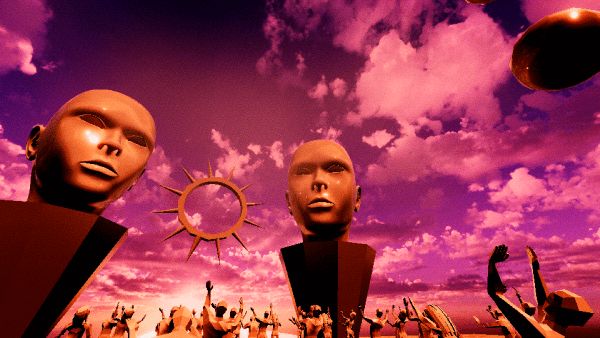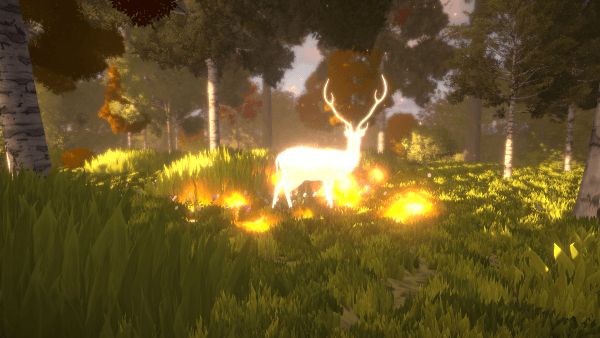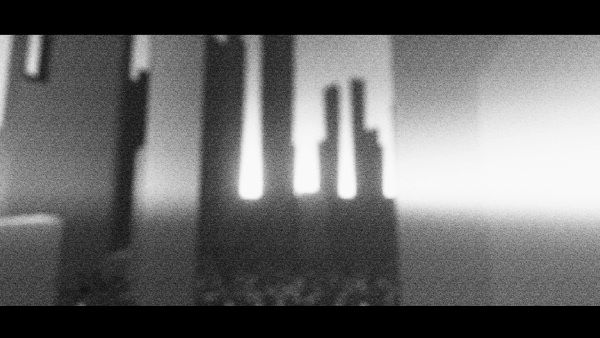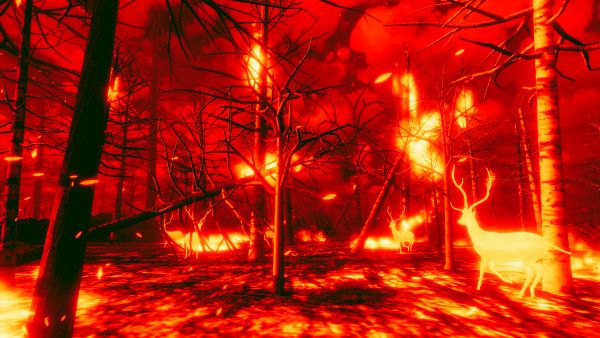🎤 Interview with Farfama
2023年 2月 18日
Farfama was kind enough to speak with us about making city::ephemera, the INFINITE TEARS collective, and more!
English

# Please tell us a little bit about yourself and your life in Japan.
I’ve been living in Japan for about 9 months now. Most of my time is spent studying Japanese, going for long walks, and aimlessly riding my rusty mamachari around Tokyo.
# How did you get started making games?
I started making games with GameMaker 20 years ago. There weren’t many options for game engines back then and GameMaker was the most accessible one with a large community.

# What projects have you worked on in the past? What are some things you learned from making them?
When I started with GameMaker, a lot of my games were simple top down shooters and casual arcade games. I learned the basics of programming and game design through tiny projects. I went on a long hiatus from making games and have only been active again the last 5 years. It was in the last 3 years that I took a big shift in the type of games I made.
Exposure to more experimental media and the isolation of the pandemic accelerated a new thought process toward the type of games I wanted to make. I wanted to explore making slower, personal games. Games that broke away from common tropes or trends. Games that respected your time. Games that elicited an unexplainable feeling. Games that I wanted to play.
I made the transition to Unity3D and have now released 5 projects. All of them are more experimental in nature compared to the GameMaker projects I made. With each new release I learn tons of new skills and techniques when it comes to both the technical and design process.
# What does your general process for game development look like?
It’s messy. I don’t have the most formal process currently. I frequently have random ideas and jot them down in a notebook. When I have a spark of motivation, I’ll open Unity and explore one of these ideas in a personal game jam. It’ll take me a few days to make a simple prototype and if I’m feeling it, I’ll spend the next few months polishing it up into a full experience.

(2022) Solastalgia
# Who are some of your favorite artists and game creators?
Limasse Five, Connor Sherlock, Nathalie Lawhead, Moshe Linke, Everest Pipkin, Jack King-Spooner, Brianna Lei. These are just a few of the countless people that I can think of from the top of my head. All of them have made games that I’ve played countless times and think about often.
Outside of games I’m a big fan of artists that explore human perception and awareness. James Turrell, Pauline Oliveros, Hiroshi Sugimoto, and Maryanne Amacher just to name a few.
# What are some of the biggest influences on your works?
It’s hard to pinpoint the biggest influence. All of the artists above have influenced my work in some way. I’m also frequently seeking out interesting media from a wide range of art disciplines to find new inspiration. I find art exhibits, museums, arthouse cinema and the countless experimental games on itch.io to be a great place to spark new creative ideas and thoughts. Every project I make is a vast collection of conscious and subconscious influences.

# Please tell us about city::ephemera and what players will experience.
I don’t want to say too much. Players will experience a lot of visual noise, sensory illusion, and subtle changes in visual and auditory perception.
# I read that you were inspired by the art installations Time Corridors and Valley Gallery, as well as the works of artists Yayoi Kusama and Hiroshi Sugimoto. Can you tell us a little bit more about them, and how those influences can be seen in city::ephemera?
Last summer I took a trip to Naoshima during the Setouchi Triennale contemporary art festival. It’s here that I got to see the works of Yayoi Kusama and Hiroshi Sugimoto in person. It was a surreal experience and I kept thinking about how I would capture this feeling in a game. If you look at the works of both artists, the influence is clear. I wanted to step into the photos I saw. Experience an endless exhibit that was living in my mind.

# What was the most challenging part of making city::ephemera?
Creatively it can be difficult to know how to limit the scope and cut out content that takes away from the experience. I want it to be concise and focused but not completely barren. I tend to focus on the micro details and pacing a bit too much. Fine-tuning something that the player only really experiences for a few seconds could take countless hours of trial and error.
Setting up the perfect post processing for the hazy art style also took a lot of fine-tuning. I played around with some subtle real-time sound mixing and aspect ratio changing for the first time as well. Doing anything for the first time is always a challenge.
# Can you tell us about the INFINITE TEARS collective?
INFINITE TEARS is an art collective I co-created that’s focused on creating a space to support, inspire, and promote alternative and experimental interactive media. The goal is to build a small community that’s focused on breaking through the limited constraints of expression imposed by the pervasiveness of rigid and oppressive profit-driven structures. It’s in the early phases but stay tuned for some announcements.

# What are you working on next?
I have about 6 projects that I’m actively working on. A few projects exploring light and space. Another one inspired by brutalist and deconstructivist architecture. A project inspired by sound artist Pauline Oliveros that explores sonic reverberations. One large scale project about a train network that takes you to fantastical locations depending on the real world time (physical train ticket needed). All of them are in a completed prototype state. Choosing which one to focus on is the hard part.
# Do you have any messages for your players?
Rate and share my games if you enjoyed them. Not required but it helps others with similar taste discover them.
# Thank you for sharing your thoughts with us!
日本語訳
日本語訳:ダイコン

# Farfamaさんについて教えて下さい。また、日本での生活についても教えてください。
私は日本に住んで約9か月くらいたちました。ほとんどの時間を日本語の勉強をしたり、長い時間散歩したり、錆びたママチャリで東京中を走り回ったりして過ごしています。
# ゲームを作り始めたきっかけについて教えてください。
20年前にGameMakerでゲーム作りを始めました。その当時は、ゲームエンジンにはあまり多くの選択肢がなく、GameMaker は大規模なコミュニティを持つ最もアクセスしやすいものでした。

# 過去にどのようなプロジェクトに取り組んできましたか? それらを作ってどんなことを学びましたか?
私がGameMakerを使い始めたとき、私のゲームの多くは単純なトップダウンシューティングゲームとカジュアルなアーケードゲームでした。小さなプロジェクトを通して、プログラミングとゲームデザインの基礎を学びました。私は長い間ゲームの制作を中断しており、活動を再開したのは最近の5年間だけです。制作するゲームの種類が大きく変わったのは、この3年間のことです。
より実験的なメディアに触れ、パンデミックで孤立したことで、私が作りたいゲームのタイプに対する新しい思考プロセスが加速しました。ゆっくりとした個人的なゲームを作りたいと思っていました。一般的な比喩やトレンドから脱却したゲーム。あなたの時間を尊重したゲーム。説明のつかない感情を呼び起こすゲーム。やりたかったゲーム。
Unity3Dに移行し、現在5つのプロジェクトをリリースしました。それらはすべて、私が作成したGameMakerプロジェクトと比較して、より実験的です。新しくリリースするたびに、技術と設計プロセスの両方に関して、たくさんの新しいスキルとテクニックを学んでいます。
# ゲームを作るときに、どのようなプロセスで作成されていますか。
整理していません。現時点では正式なプロセスはありません。私はよくランダムなアイデアをうかべるので、ノートにそれを書き留めます。やる気が湧いてきたら、Unityを開いて、個人的にゲームジャムを開始してこれらのアイデアの1つを探ります。簡単なプロトタイプを作成するのに数日かかりますが、感触がいい場合は、次の数か月をかけて完全な体験に磨き上げます。

# お気に入りのアーティストやゲームクリエイターを教えてください。
Limasse Five、Connor Sherlock、Nathalie Lawhead、Moshe Linke、Everest Pipkin、Jack King-Spooner、Brianna Lei。これらは、私が頭の中で思いつく限りの無数の人々のうちのほんの一部です。このすべてのクリエイターたちのゲームを、私は数え切れないほどプレイしました。そしてよくそのゲームについて考えました。
ゲーム以外では、人間の知覚と認識を探求するアーティストの大ファンです。ほんの数例を挙げるとJames Turrell、Pauline Oliveros、Hiroshi Sugimoto、そしてMaryanne Amacher。
# このゲームを作成するにあたり、最も影響を受けたものは何ですか?
最も影響を受けたものを特定することは困難です。上記のすべてのアーティストは、何らかの形で私の作品に影響を与えています。また、新しいインスピレーションを得るために、さまざまな芸術分野から興味深いメディアを頻繁に探しています。美術展、美術館、アートハウスシネマ、itch.ioの無数の実験的ゲームは、新しい創造的なアイデアや思考を刺激する絶好の場所だと思います。私が作成するすべてのプロジェクトは、意識的および潜在意識の影響の膨大なコレクションです。

# 「city::ephemera」というゲームについて教えてください。そして、プレイヤーにとってどのような経験になるのかを教えてください。
あまり語りたくありません。プレイヤーは、多くの視覚的ノイズ、錯覚、および視覚と聴覚の微妙な変化を経験することになります。
# インスタレーション・アートの「時の回廊」と「ヴァレーギャラリー」、アーティストの草間彌生と杉本博司の作品に触発されたと伺っております。それらについてもう少し詳しく教えてください。また、それらの影響が「city::ephemera」でどのように見られますか?
昨年の夏、私は瀬戸内国際芸術祭の期間中に、直島へ旅行に行きました。ここで草間彌生さんと杉本博司さんの作品を直に見てきました。シュールな体験だったので、この感覚をゲームでどう表現するかをずっと考えていました。両アーティストの作品を見れば、その影響は明らかです。それらの写真に足を踏み入れたいと思いました。私の心に住んでいる無限の展示物を体験してください。

# 「city::ephemera」の作成で最も難しかった部分は何ですか?
創造的に視野を制限し、得られる経験からコンテンツを切り取る方法を理解することは難しい場合があります。簡潔で焦点を絞ったものにしたいのですが、完全に不毛なものにはしたくありません。私は細かいディテールとペーシングに集中しすぎる傾向があります。プレイヤーが実際に体験できるのはほんの数秒ですが、その微調整には数え切れないほどの試行錯誤が必要になる可能性があります。
ぼんやりとしたアートスタイルに最適な後処理を設定するには、多くの微調整も必要でした。微妙なリアルタイムサウンドミキシングとアスペクト比の変更も初めて試しました。初めて何かをすることは常に挑戦です。
# INFINITE TEARSについて教えてください。
INFINITE TEARSは、私が共同で作成したアート集です。伝統から外れた実験的なインタラクティブなメディアをサポートし、刺激、促進するためのスペースの作成に重点を置いています。目標は、固く閉ざされた抑圧的な利益主導型の構造の普及による表現の制約を打ち破ることに焦点を当てた小さなコミュニティを構築することです。初期段階ですが、いくつかの発表をお待ちください。

# 今取り組んでいるプロジェクトなどがあればご紹介お願いします。
私は約6つのプロジェクトに積極的に取り組んでいます。光と空間を探求するいくつかのプロジェクト。残忍で脱構築主義的な建築にインスパイアされたもの。音響の残響を探求するサウンド アーティストPauline Oliverosにインスパイアされたプロジェクト。現実世界の時間に応じて幻想的な場所に連れていく電車ネットワークに関する大規模なプロジェクト(実際の電車のチケットが必要です)。いずれも完成した試作品の状態です。これらのどれに焦点を当てるかを選択するのは難しい部分です。
# プレイヤにコメントをお願いします。
もしこのゲームを楽しんでいただけたなら、是非ゲームを評価してください。必須ではありませんが同じようなテイストを持った方がこのゲームを見つけることの助けになります。
# この度はインタビューにご協力いただき誠にありがとうございます。

